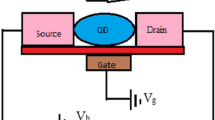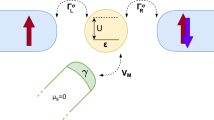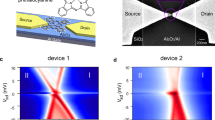Abstract
How localized electrons interact with delocalized electrons is a central question to many problems in sold-state physics1,2,3. The simplest manifestation of this situation is the Kondo effect, which occurs when an impurity atom with an unpaired electron is placed in a metal2. At low temperatures a spin singlet state is formed between the unpaired localized electron and delocalized electrons at the Fermi energy. Theories predict4,5,6,7 that a Kondo singlet should form in a single-electron transistor (SET), which contains a confined ‘droplet’ of electrons coupled by quantum-mechanical tunnelling to the delocalized electrons in the transistor's leads. If this is so, a SET could provide a means of investigating aspects of the Kondo effect under controlled circumstances that are not accessible in conventional systems: the number of electrons can be changed from odd to even, the difference in energy between the localized state and the Fermi level can be tuned, the coupling to the leads can be adjusted, voltage differences can be applied to reveal non-equilibrium Kondo phenomena7, and a single localized state can be studied rather than a statistical distribution. But for SETs fabricated previously, the binding energy of the spin singlet has been too small to observe Kondo phenomena. Ralph and Buhrman8 have observed the Kondo singlet at a single accidental impurity in a metal point contact, but with only two electrodes and without control over the structure they were not able to observe all of the features predicted. Here we report measurements on SETs smaller than those made previously, which exhibit all of the predicted aspects of the Kondo effect in such a system.
This is a preview of subscription content, access via your institution
Access options
Subscribe to this journal
Receive 51 print issues and online access
$199.00 per year
only $3.90 per issue
Buy this article
- Purchase on Springer Link
- Instant access to full article PDF
Prices may be subject to local taxes which are calculated during checkout




Similar content being viewed by others
References
Lawrence, J. M. & Mills, D. L. Recent progress in heavy fermion/valence fluctuation physics: Introduction. Comments Cond. Mat. Phys. 15, 163–174 (1991).
Grüner, G. & Zawadowski, A. Magnetic impurities in non-magnetic metals. Rep. Prog. Phys. 37, 1497–1583 (1974).
Varma, C. M. Mixed-valence compounds. Rev. Mod. Phys. 48, 219–238 (1976).
Ng, T. K. & Lee, P. A. On-site Coulomb repulsion and resonant tunneling. Phys. Rev. Lett. 61, 1768–1771 (1988).
Glazman, L. I. & Raikh, M. E. Resonant Kondo transparency of a barrier with quasilocal impurity states. JETP Lett. 47, 452–455 (1988).
Meir, Y., Wingreen, N. S. & Lee, P. A. Low-temperature transport through a quantum dot: the anderson model out of equilibrium. Phys. Rev. Lett. 70, 2601–2604 (1993).
Wingreen, N. S. & Meir, Y. Anderson model out of equilibrium: Noncrossing approximation approach to transport through a quantum dot. Phys. Rev. B 49, 11040–11052 (1994).
Ralph, D. C. & Buhrman, R. A. Kondo-assisted and resonant tunneling via a single charge trap: a realization of the Anderson model out of equilibrium. Phys. Rev. Lett. 72, 3401–3404 (1994).
Fulton, T. A. & Dolan, G. J. Observation of single-electron charging effects in small tunnel junctions. Phys. Rev. Lett. 59, 109–112 (1987).
Meirav, U. & Foxman, E. B. Single-electron phenomena in semiconductors. Semiconductor Sci. Technol. 10, 255–284 (1995).
Kastner, M. Artificial atoms. Phys. Today 46, 24–31 (1993).
Ashoori, R. C. Electrons in artificial atoms. Nature 379, 413–419 (1996).
van Wees, B. J. et al. Quantized conductance of point contacts in a two-dimensional electron gas. Phys. Rev. Lett. 60, 848–851 (1988).
Wharam, D. A. et al. One-dimensional transport and the quantisation of the ballistic resistance. J. Phys. C: Solid State Phys. 21, L209–214 (1988).
Meirav, U., Kastner, M. A. & Wind, S. J. Single-electron charging and periodic conductance resonances in GaAs nanostructures. Phys. Rev. Lett. 65, 771–774 (1990).
Johnson, A. T. et al. Zero-dimensional states and single-electron charging in quantum dots. Phys. Rev. Lett. 69, 1592–1595 (1992).
Weis, J., Haug, R. J., Klitzing, K. v. & Ploog, K. Competing channels in single-electron tunneling through a quantum dot. Phys. Rev. Lett. 71, 4019–4022 (1993).
Foxman, E. B. et al. Crossover from single-level to multilevel transport in artificial atoms. Phys. Rev. B 50, 14193–14199 (1994).
Wan, Y., Phillips, P. & Li, Q. Suppression of the Kondo effect in quantum dots by even–odd asymmetry. Phys. Rev. B 51, R14782–14785 (1995).
König, J., Schmid, J., Schoeller, H. & Schön, G. Resonant tunneling through ultrasmall quantum dots: Zero-bias anomalies, magnetic-field dependence, and boson-assisted transport. Phys. Rev. B 54, 16820–16837 (1996).
Hershfield, S., Davies J. H. & Wilkins, J. W. Probing the Kondo resonance by resonant tunneling through an Anderson impurity. Phys. Rev. Lett. 67, 3720–3723 (1991).
Dobers, M., von Klitzing, K. & Weimann, G. Electron-spin resonance in the two-dimensional electron gas of GaAs–AlxGa1−xAs heterostructures. Phys. Rev. Lett. 38, 5453–5456 (1988).
Acknowledgements
We thank G. Bunin for help with fabrication, N. Y. Morgan for help with measurements, and I. Aleiner, R. C. Ashoori, M. H. Devoret, D. Esteve, D. C. Glattli, A. S. Goldhaber, L. Levitov, K. Matveev, N. Zhitenev, and especially N. S. Wingreen and Y. Meir for discussions. This work was supported by the US Joint Services Electronics Program under contract from the Department of the Army, Army Research Office. D.G.-G. thanks the students and staff of the Weizmann Institute's Braun Center for Submicron Research for their hospitality during his stay there, and the Hertz Foundation for fellowship support. D.A.-M. thanks the Lucent Technologies Foundation for fellowship support.
Author information
Authors and Affiliations
Corresponding author
Rights and permissions
About this article
Cite this article
Goldhaber-Gordon, D., Shtrikman, H., Mahalu, D. et al. Kondo effect in a single-electron transistor. Nature 391, 156–159 (1998). https://doi.org/10.1038/34373
Received:
Accepted:
Issue Date:
DOI: https://doi.org/10.1038/34373
This article is cited by
-
Modulated Kondo screening along magnetic mirror twin boundaries in monolayer MoS2
Nature Physics (2024)
-
Probing electron dwell time in quantum dots through pulsed conductance analysis
Journal of the Korean Physical Society (2024)
-
Single PbS colloidal quantum dot transistors
Nature Communications (2023)
-
Quantum simulation of an exotic quantum critical point in a two-site charge Kondo circuit
Nature Physics (2023)
-
Spin-polarized Majorana zero modes in proximitized superconducting penta-silicene nanoribbons
Scientific Reports (2023)
Comments
By submitting a comment you agree to abide by our Terms and Community Guidelines. If you find something abusive or that does not comply with our terms or guidelines please flag it as inappropriate.



